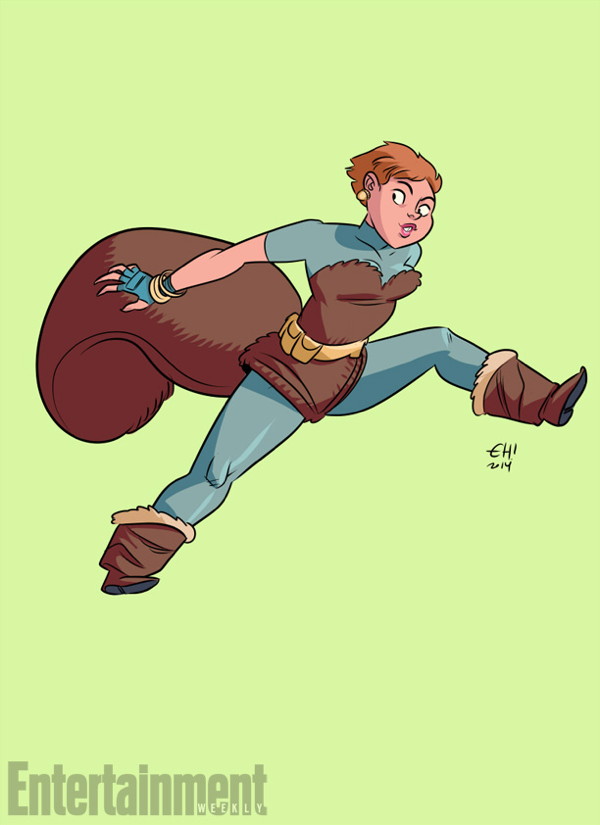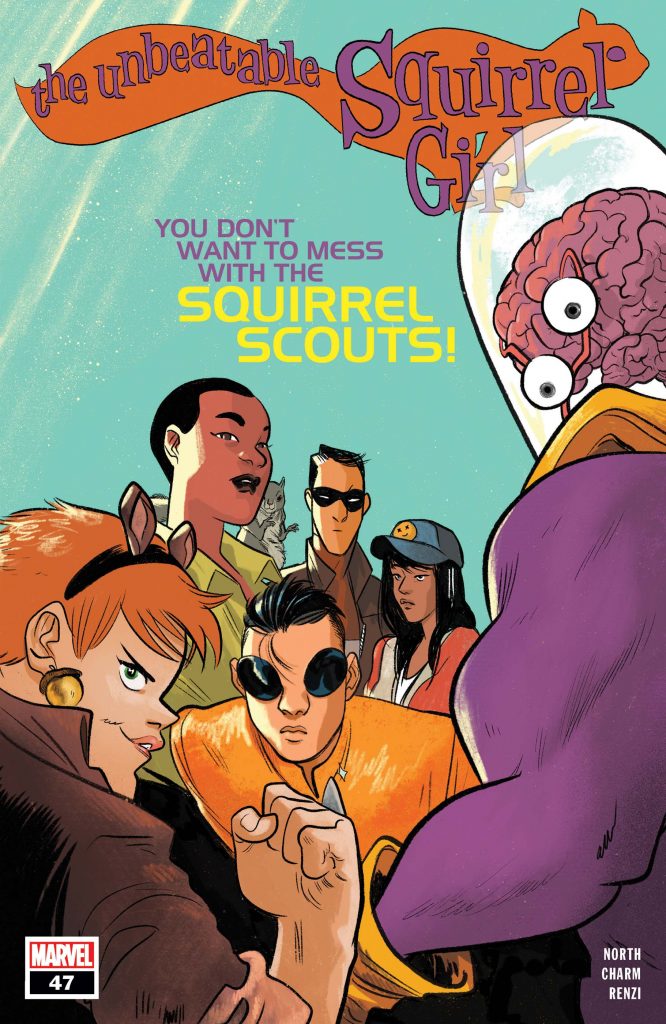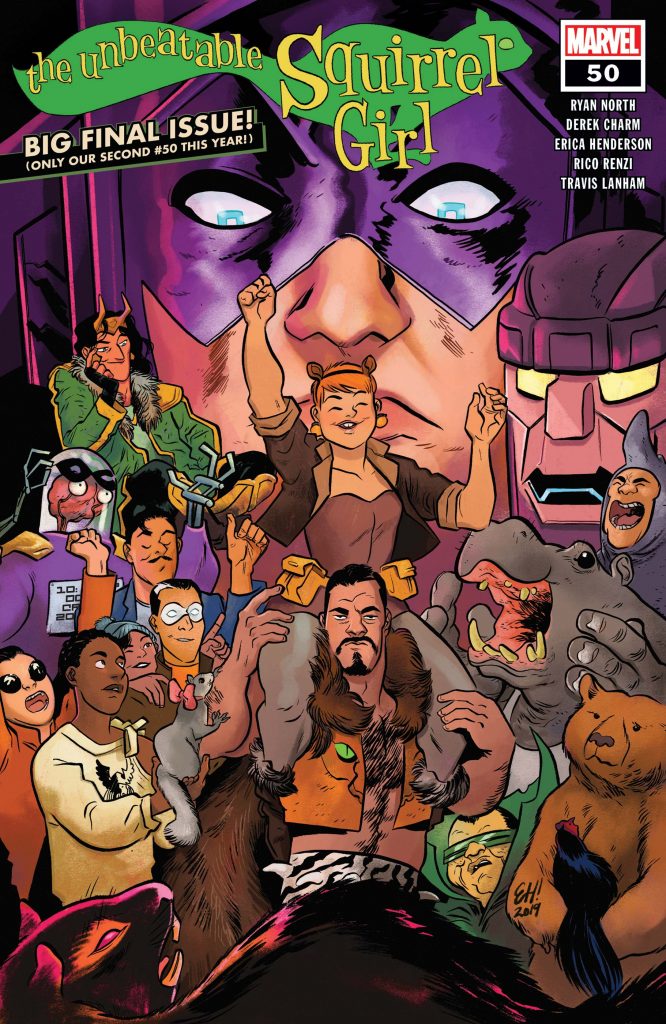Empathy, Footnotes and Family: The Story Behind The Unbeatable Squirrel Girl, Before It Ends
I can tell you the exact moment I knew The Unbeatable Squirrel Girl was something special. It was in the fourth issue of the title’s first volume, as Squirrel Girl and her trusty sidekick/best friend Tippy-Toe (who is a squirrel, of course) face off with Galactus on the moon. We’ve been building to it, and predictably, it’s a one-sided affair…
Favoring Squirrel Girl, of course.
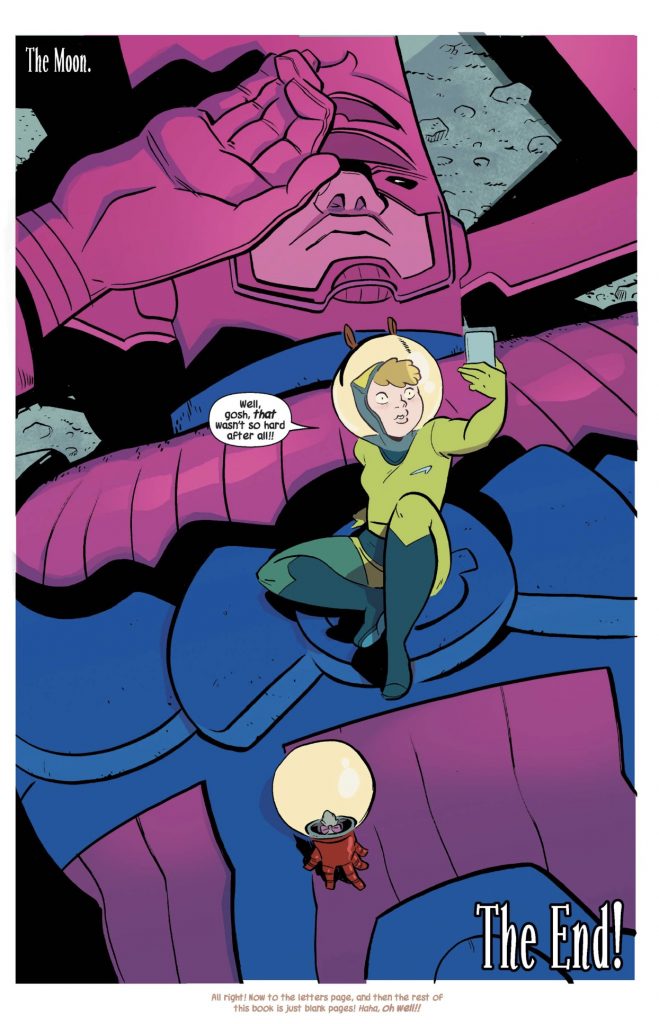
The first page of the issue doubles as its last, with Squirrel Girl and Tippy-Toe triumphantly taking a selfie above the defeated body of Galactus. Roll credits – literally, as it jumps into the letters column on the second page – and have a nice day. Except, you know, it wasn’t the end, with 19 pages still to go in the issue and the entire story to be told. But that decision to show victory and then jump to the letters column off the top was indicative of something that stood out about this series even from the start: the only rigidity within it was its unrelenting rejection of superhero norms, whether that means atypical story opens, outside-the-box problem solving, or footnotes within the story. That made me love it, as did the rest of the issue, which was basically a chill hang between Doreen (aka Squirrel Girl), Tippy and Galactus on the moon instead of…whatever an actual fight between Galactus and Squirrel Girl would be like.
However, I have to mention this: before I loved it, I was deeply skeptical of the The Unbeatable Squirrel Girl. When it was first announced – as I wrote in the very first review I ever published on SKTCHD – there was a part of my brain that thought it was outrageous Marvel would even publish a Squirrel Girl series. “This isn’t what a Marvel superhero is,” I might have thought then. She was a one-note gag character famous for beating the most super of supervillains off panel. How dare they publish this series when they could be giving me more of something I considered superior, like my precious Nextwave?
But over its 58 issues – with its final issue dropping tomorrow – and single graphic novel release, this series proved itself every bit as effective at rejecting the superhero premise while simultaneously perfecting it as my beloved Nextwave was. I was right when I said that Squirrel Girl wasn’t what a Marvel superhero was; she and her series were more important than that. They were the perfect representations of what Marvel could be. And that, my friends, was a far more interesting and rewarding idea than just going with the usual playbook.
So on the last day before there’s no more of this wondrous, unforgettable, truly unbeatable series, I wanted to look back on The Unbeatable Squirrel Girl with the help of the people who made it what it was. Without Ryan North, Erica Henderson, Derek Charm, Rico Renzi, Wil Moss and friends, none of this would have been possible. This series needed a crack team who could find the nut in the acorn that was Squirrel Girl, and it found the one that could do just that. To celebrate that, we’ll be looking back on how this series came together before examining what exactly made it special, with insight from the bulk of the creative team along the way.
Once upon a time, the idea of Squirrel Girl getting a solo series was an outlandish concept. Before her solo series, she was seemingly little more than a joke regularly worked into issues of Great Lakes Avengers or, more bizarrely, the nanny to Luke Cage and Jessica Jones’ daughter during Brian Michael Bendis’ time on New Avengers. Whenever there’s a character like that, they need an evangelist to become something more. The genesis of The Unbeatable Squirrel Girl starts there, as this character had its advocate in the form of one of Marvel’s longest-tenured employees.
“It was Tom Brevoort’s idea to give her a solo book,” series editor Wil Moss told me. “He and Dan Slott had featured the character in a number of stories over the years, and I think Tom had been waiting for the right moment to do something bigger with the character.”
The title still needed approval, and to give direction to the pitch, artist Erica Henderson was asked by Moss for a drawing of the character. That was also an effort to gauge her interest in the project if it ever came to be.
“I got an email asking if I wanted to work on a Squirrel Girl book,” Henderson said. “He, and I assume Brevoort, were pitching it internally still. So this was actually more of a, ‘Would you want to do a Squirrel Girl book if we can make it happen?’”
For Henderson, the appeal to this project was undeniable. But it wasn’t in relation to the character or idea, really. It was a foot in the door, and one she had been waiting for.
“What attracted me honestly was that this was a big job,” she said. “I’m not going to lie. It was real work in a field that I’d been very slowly breaking into.”
Once the project was approved, it needed a creative team. Moss had previously worked with writer Ryan North on a five-part Young Avengers story in Original Sins, an anthology mini-series, so when Brevoort suggested North for Squirrel Girl, he was all about it. While sometimes the right team can take time to find, this was not the case here. As Moss noted, “it was honestly that easy,” as it was just a conversation between him and Brevoort to finalize Henderson and North as the picks. Moss viewed each creator as having essential characteristics to making a Squirrel Girl title work.
“I liked how Ryan treats all the characters he writes with respect,” Moss said. “We knew Squirrel Girl was perceived by a lot of people as a joke character and thus would need someone who would counteract that assumption. Plus, the guy is crazy inventive and funny.”
“With Erica, there was just an undeniable enthusiasm and charm in her art that felt right for the character,” he added. “And I knew, even from working with her on just that two-page story (Editor’s note: From Original Sins as well), that she put as much thought into her art as Ryan put into his writing, so on a gut level I felt like they’d make a good match.”
From there it was finding a letterer – initially Clayton Cowles before Travis Lanham took over and handled the bulk of it – and a colorist for the title. The latter ended up being one of the rocks for the series: Rico Renzi. At the time he signed on, he was acting as the creative director for HeroesCon on top of his role as a colorist. That consumed a lot of his time, so when Moss offered him an Avengers title, he had to pass because a team book would be too time-consuming. The next day, Moss made him an offer he couldn’t refuse.
“He sends me Ryan’s outline and I believe a few of Erica’s first character design attempts. I was so taken with the bounce of Erica’s drawings and the great combination of Marvel-style action and humor in Ryan’s pitch that I knew right away I had to be a part of this thing!” Renzi shared. “Funny superhero books don’t seem to last long at Marvel/DC so I figured I was signing up for around 12 issues.”

Thus, The Unbeatable Squirrel Girl was born, at least in theory. Now they just had to make the comic about a character who had very little development over her 23-year existence. She was still a mystery, even to the core creators who would be working on her title.
“I think I had actually, for some reason, read the first story. The Ditko, Will Murray one,” Henderson said about her awareness of the character. “So I knew about that and then I just had a general sense of the running gag of the character where she gets pulled in and off screen defeats someone.”
“I was basically going in cold!” North shared. “I was lucky that there wasn’t a lot of Squirrel Girl books to read at that time, so I could, over the course of just a few hours, read every single comic that Squirrel Girl had ever appeared in. That’s a rare treat when you’re working on an established character!”
Having little experience with a for-hire character can be a problem for creators…unless there isn’t much to work off of to begin with. In that case, it’s something much different. Squirrel Girl – or Doreen Green, as she’s known to her friends – was a blank slate, and someone whom North, Henderson and the rest of the team could define on their own. That was essential to the book becoming what it was, as it allowed this team to find the best answers for the character.
“Erica did sheets of different character designs, just all sorts of jumping-off points, all from scratch. She told me her first question to Wil was ‘can I change her costume?’” North said. “And Wil told me that I could feel free to take or ignore anything that had been established before.
“It was really open and freeing, and it gave us all the space and trust that was needed to do something different with her!”
Henderson shared that her and North were aligned from the jump, despite not knowing each other before then, saying “we just clicked instantly.” That allowed the pair to develop Doreen’s world and fill it out with interesting new characters like her college roommate Nancy Whitehead and assorted other pals like Chipmunk Hunk, Koi Boi and Brain Drain.
“There was a lot that was just sort of came purely from Ryan and I, even in terms of who Doreen Green is because that part of it hadn’t been explored all that much,” Henderson said. “We were making up our own people and telling those stories, but still getting to play with those toys because you had all the other Marvel characters just running around in the background.
“It was kind of the best of both worlds.”
North’s original pitch was for an all-ages series that would be welcoming to readers of all varieties, at least in part because it wouldn’t be too steeped in Marvel continuity. That worked for two reasons: one, North thought it was a good idea, and two, he “inititally didn’t have a huge well of Marvel knowledge to draw from.”
“So it was both a good idea and a clever and self-serving idea.”

The first story in the pitch was the same at the core as what was eventually released – Squirrel Girl versus Galactus – but there were pieces missing. It was just those two characters “doing their thing,” according to North. There was no Nancy, no Chipmunk Hunk, or anyone else that filled out Squirrel Girl’s world and made it real. Moss quickly noted the absence, as North told me.
“I sent it into Wil and he wrote back and said ‘Great, but who are the other people in her life?’ and I was like, ‘Oh right, right, yes that would be what a competent writer would do.’”
Early on in the pitch, there was going to be a regular “solving mysteries on campus” element, per North. That’s a very Doreen kind of thing to include, but it was scrapped when Gotham Academy arrived on the scene with a similar angle. Another key change was her major in college, as North changed it to English because he was concerned it was “a little self-serving” having the character study what he did in school. That flipped back to the subject that made it into the book and something that was a key characteristic within the story – computer science – when North’s wife rightfully told him he was “being insane.”
The biggest change from the initial pitch was maybe the most significant moment of its development phase, though. It’s another tweak that came from Moss. In the first issue, Doreen faces off against Kraven the Hunter on campus, and in the original script “she just stuck squirrels down his pants and then beat him that way.” That is…definitely not what happened in the comic, and we have the series editor to thank for that.
“Wil (Moss) read it and told me that he always saw Doreen as someone who’d help people with their problems, and I tell you, it was like reading the answer sheet at the back of the book,” North said. “Of course that’s who Doreen is! It’s crazy that something to fundamental to who Doreen is – that’s really come to define her – was this empathy and understanding she brings to everyone… and it wasn’t there when we started out.”
“But as soon as I had that note I could instantly see who Doreen was and was acutely embarrassed by that earlier draft that had this weird non-Doreen in it,” he added. “When she finally arrived, it was fully formed.”
Early on, Henderson and North “decided to go with a version of the character who was younger,” the artist told me. With little definition to Doreen’s age outside of her introduction as a 14-year-old, Henderson said they chose their own track at least in part because trying to jam her history into “a single chronology is insane.”
That allowed for two key elements to be there from the jump. There was that “all-ages” nature that North spoke to, as Doreen’s youthfulness made it a bit easier for that to work. This was an intentional effort to make the title easy to dive into even if The Unbeatable Squirrel Girl was someone’s first comic ever. The other was having her in college made the aforementioned computer science element a shockingly useful tool to differentiate her from her heroic peers, as a substantial part of what made Squirrel Girl unbeatable was her brain.
“It gave a fun way for Doreen to use the stuff she’s learning in school to save people,” North said.
Once Henderson had defined the look of everyone, one of the biggest things she had to do was sort out how to tell the stories based off North’s scripts. While noting she doesn’t meaning this as “a huge diss” and that she’d talked to him about it before, she said North didn’t have a visual sense locked in, so sometimes she’d have to rework his scripts to make beats pop more. A good example came in the first issue when Doreen yells “Put the squirrel down!” at Kraven. Originally it was one panel.
“To give it the kind of presence that that moment needs, I made it three panels where it was, ‘Put.’ ‘The squirrel.’ ‘Down.’” Henderson told me. “If you read it as one sentence, it comes out as, ‘Put the squirrel down.’ If you break it up, you create that beat that would happen if you make someone read it in a different cadence.”
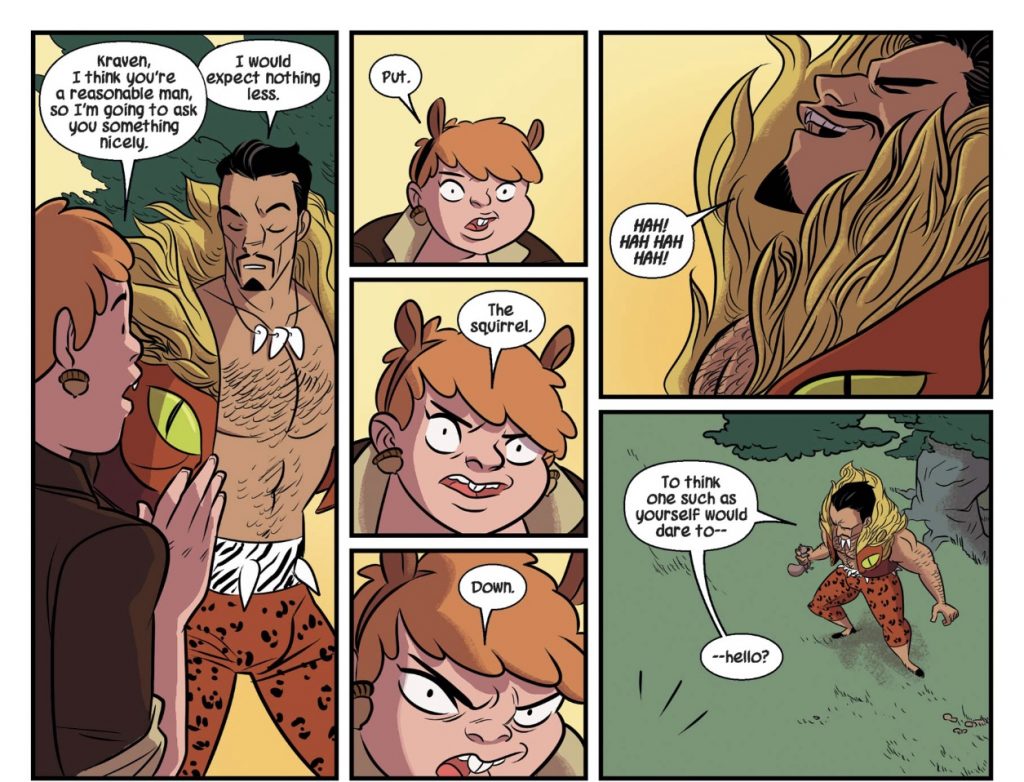
Those kinds of things were important to the series working as well as it did, and North’s flexibility and Henderson’s rare gifts as a visual storyteller helped it become what it was. Renzi’s colors helped immensely too, as he always excelled at bringing this world to life while controlling our emotions in the process. His goal was to complement Henderson’s work above all.
“When we first started I think I was trying to color Erica as close to the way she colors herself as I could manage,” Renzi said. “I think the colors on the earlier issues ended up somewhere between Fleischer Superman and Spider-Man and his Amazing Friends cartoons. As the series went on and especially when (eventual series artist) Derek (Charm) took over the colors became pretty streamlined and clear.”
With the book locked in and its identity figured out, both from a writing and visuals standpoint, it was now upon the readers to see if it was an idea that would last. Remember, Renzi hypothesized this was the kind of project that would last 12 issues. He would usually be correct. That was even the internal belief to a degree, as Moss said the thinking at Marvel was “let’s try it and see what happens.”
“Expectations weren’t high,” Moss said. “It was when we went back to press on #1-5 and got encouraged to do something fun with the covers for the reprints — which led to the ‘EATS NUTS KICKS BUTTS!!!’ covers — that I knew the book wasn’t going anywhere.”
It sure wasn’t. Renzi’s theoretical 12-issue gig became 58 and a graphic novel, and a year became nearly five. There were many reasons for that, many of which we’ll get to. But it helped that from the start it was a genuinely outstanding comic. The premise was a good one, but North, Henderson (and then Charm), Renzi, Cowles (and then Lanham) proved to be an exemplary team whose execution outdistanced its concept. Armed with the rare gift of blue sky thinking with a Marvel character, this team did not play it safe. This made for a special series with attributes that were wholly its own.
Maybe my favorite of all of those was something we already noted, and that’s Doreen’s leanings towards atypical solutions for supervillain-like problems. When faced with Galactus or Kraven the Hunter, Doreen’s the kind of person who’s more likely to try and hash out their problems and find alternative solutions rather than immediately diving into fisticuffs. North wanted Doreen to approach it differently.
“If Doreen is this smart and thoughtful person, even if she’s in this world and genre of superheroes, she’s going to try to think of what the best approach here is,” North said. “And I’d suggest that it’s usually not a punch to the face. So if I’m going to be honest to who Doreen is, I’ve got to start thinking of better ways to solve these problems!”
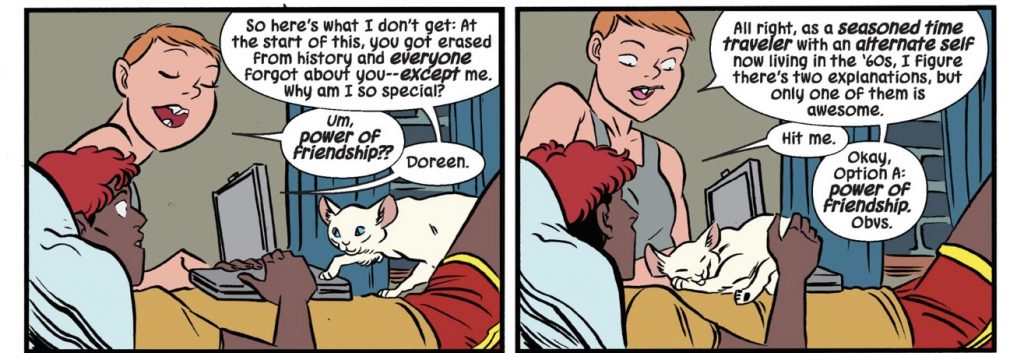
The solution tended to be the “power of friendship,” as North called it, or an “ability to turn enemies into allies” that comes “from being a decent person who wants to help people.” That’s a huge part of why North himself connected with the character, saying “She does her best, and she asks that those around her do the same, and if they don’t she tries to help them.
“It doesn’t sound that revolutionary, and maybe it isn’t, but it’s why I love her.”
No character was a better exemplar of that idea than Kraven, a villain mostly known for hunting people and animals and really anything that was dangerous. The pairing of this baddie with an animal-themed hero makes sense, but that wasn’t why the character appeared in the story. North just enjoyed Kraven, particularly when depicted by his pal Kate Beaton. That’s the long and the short of why he appeared in the first issue. But then he came back. And he came back again. And he kept coming back, over and over, becoming one of Doreen’s trustiest allies and the most potent showcase for the power of friendship.
“I wasn’t expecting him to return,” North said. “But when we did bring him back, and we started to see how being with Doreen had influenced him, had started to make this really positive change in his life, I was super into it. He goes from not thinking much of her, to respecting her, to eventually having a nickname for her and treating her as a trusted confident who inspires him to be better.
“I just love that, and their relationship – even if it’s just for a few issues here and there – is one of my favourites in the comic.”

Of course, there’s a flipside to this equation, as not everyone will bend to the iron will of friendship Doreen brings to the table. The best example is Squirrel Girl’s arch-nemesis Melissa Morbeck, the one villain created for the book. As North noted to me, they’re a fascinating pair because both Doreen and Morbeck are “rational, logical, clever people in a comic book universe,” making them anomalies at Marvel. Unfortunately for Doreen, Morbeck uses her power and powers for nefarious means and, also unfortunately, to destroy Doreen by revealing her identity to the world and uniting a legion of super-villains to defeat her in the final arc. It’s exactly what Doreen would do if she was a villain. TBD if she’s successful, but North viewed Morbeck as the perfect foe to conclude the series with because of her funhouse mirror nature.
Lowkey one of the other greatest strengths of this series was its robust nature. Not to get too consumer reports on you, but reading an issue of The Unbeatable Squirrel Girl takes time, so it feels like it’s “worth it,” if you will. It’s a long, dense read, filled with details you won’t find in almost any other comic. Those details – like footnotes on almost every page, supervillain cards Doreen carries curated by Deadpool that come loaded with info on each baddie, and Twitter-like social media intros to each issue – don’t just add to the pro side of the cost-benefit analysis. They make the book a deeper, most inviting read. A pair of those solutions originated elsewhere.
“The footnotes came from my work on Adventure Time comics, which came from my alt texts from my webcomic Dinosaur Comics, which came from the alt text in Achewood,” North said. “So blame Chris Onstad.”
Moss said Marvel was always onboard with the footnotes, describing them as “part of the Ryan North package.” And they were immensely valuable as well. They both allowed for silly gags outside of the main text but also for quick, enjoyable explainers of something happening within the story. North described them as “surprisingly useful” and something that could offer an elegant solution to the problem of making a comic more accessible.
The Deadpool cards, on the other hand, came from an earlier Squirrel Girl comic: the GLXmas Special from 2005. Doreen carried Iron Man Vs. Series Battle Cards containing villain stats that “kinda” broke the fourth wall in the process, according to North.
“I decided to remove the fourth-wall breaking and to make the cards fully in-universe, and it was only afterwards that I realized what a fantastic structure they were – something I’d invented entirely by accident.”
Instead of panel after panel describing character minutiae, these cards allowed for a quick Wikipedia-like update for readers, giving them what they needed to know about these characters on the fly.
“I used them a lot because they were so efficient, but also really fun and funny ways to get that exposition across,” North said. “It made the comics accessible to everyone.”
Many artists supplied art for these cards over the title’s run, with Renzi himself lifting a fair bit of the load later on in the series. But for a decent chunk of the run, Henderson said she “was getting (her) friends to come in and draw them,” starting with artist Maris Wicks in the first issue.
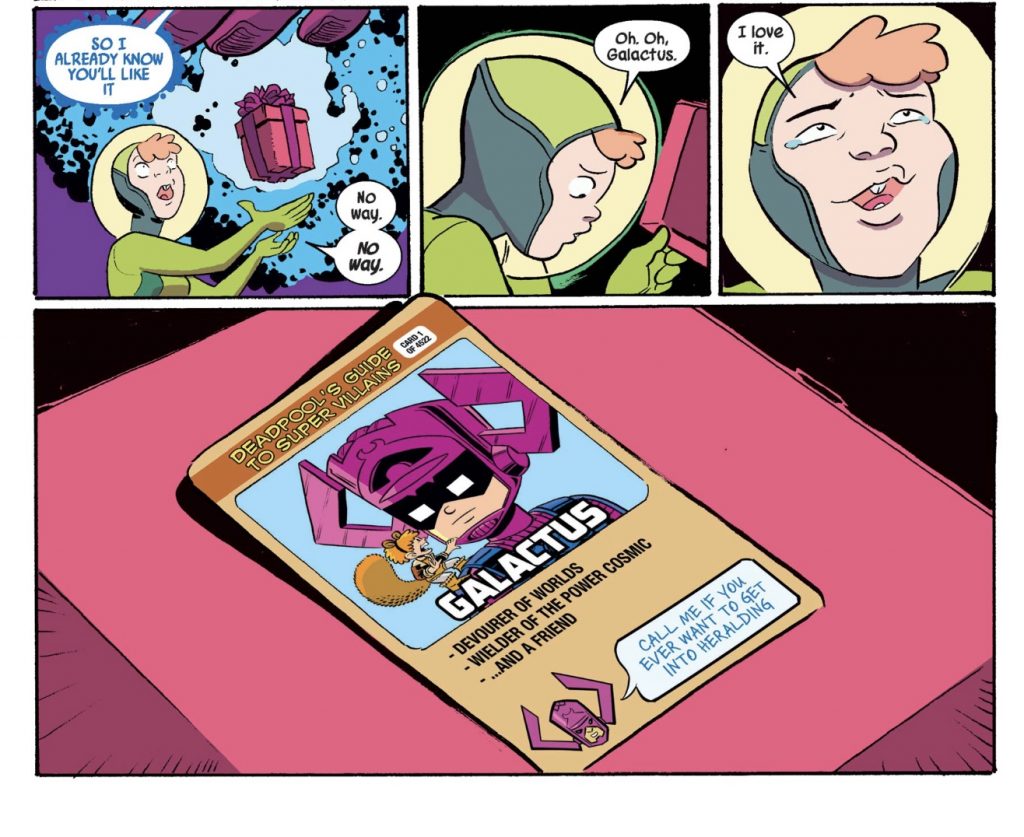
This all fit the effort the team put into making the comic accessible. Henderson, for one, found Marvel comics impossible to get into as a kid because you’d pick up an X-Men comic as a fan of the animated series and still have no idea who someone was or what was happening.
“I’ll know all the characters, I’ll still have no idea what’s going on, and it’s a barrier,” she told me. “I think cutting that out really helped a lot of people. There are people who have said it’s nice that I don’t have to worry about all this stuff when I’m reading this book.”
That is likely a big reason why the title’s letters column was always loaded with messages from adoring younger readers or parents. There can be an imperviousness to the medium even if kids already know the heroes, so lowering the barrier to entry was a core focus for the team.
“There always needs to be comics written in a way that children can access, because it’s the children reading comics who grow up into adults reading comics, who sometimes grow up into adults having children of their own who read comics,” North said. “I know we’ve gotten letters from adults happy that there’s something in the Marvel Universe they can share with their kids, and I hope that continued indefinitely.”
That’s not to say this was a kid-centric comic. It truly was an all-ages read, and Charm – who took over regular art duties on the series with the 32nd issue of the second volume – thought the biggest reason for that was the “genuine quality to the character that people respond to.”
“I’ve said before that these characters started to feel like real people over the two years I worked on this book. And they were people that you liked and wanted to be friends with,” Charm said. “I feel like that’s something very unique and not something I would have expected coming in.”
That genuine nature ties into something you may have noticed within this article. Squirrel Girl herself has entered rarefied air in the sense that at least this reader finds himself calling her “Doreen” as much as “Squirrel Girl.” As Charm mentioned, she resembled someone you wanted to be friends with, so calling her Doreen just feels right. North does that himself, it turns out, and he had a guess as to why that is.
“I think it’s really interesting, because you can have these conversations about ‘is Bruce or Batman the mask’ or ‘is Clark or Superman who he really is,’ but for Squirrel Girl, there’s really no split,” he said. “Doreen is the same when she’s Squirrel Girl as when she’s Doreen, and she just feels like a whole person.
Of all of the elements that made The Unbeatable Squirrel Girl work, though, the idea of “family” was probably the secret sauce. It works in two ways, and we’re going to start with the characters in the book. The crew in the title – Doreen, Tippy-Toe, Nancy, Chipmunk Hunk, Koi Boi, Brain Drain, etc. etc. – didn’t just feel like they were friends, but the kind of friends that become your surrogate family. The ones beyond intermittent “happy birthday” messages on social media or occasional texts of “We should catch up!” before you never do. That kind of family makes this cast feel like something different, and perhaps more real and reflective of the way the world works today. You can’t choose your family, but you can elevate friends. Doreen has one heck of a family because of that. It’s a crucial part of the book, and at the heart of what makes it what it is.
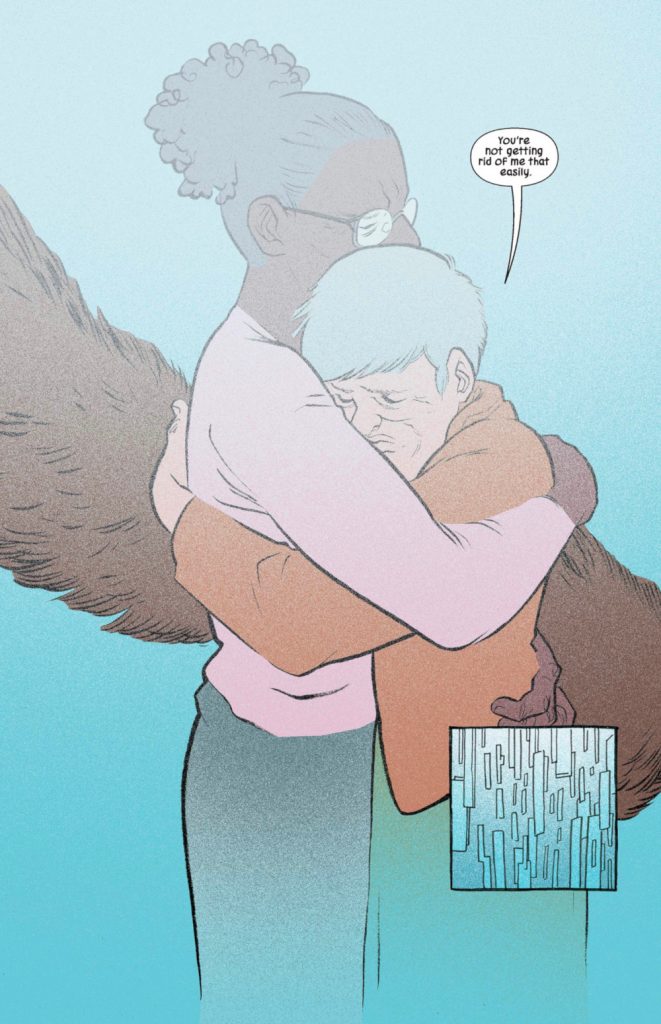
No issue showcased that better than #31, in which Doreen and Nancy get trapped in Hypertime, or, they are moving so fast relative to everyone else that they live the rest of their lives over the span of weekend as they try to find a way out of the pickle they got into. What ensues is just that: Doreen and Nancy growing old while saving people and attempting to save themselves, sharing a life that’s perfect and wonderful because they’re together, even if it isn’t the one they always dreamed of. It is, in my opinion, the best issue of the entire series, and a true heartbreaker that encapsulates everything special about the title.
Interestingly enough, it also doubles as the final issue for Henderson, as three plus years and 39 issues (and a graphic novel!) proved to be enough for her. As much as she enjoyed her time on the series and loved the characters, she just “needed to do something else.” She kept on with creating covers for the series, but that was her last regular issue on interiors.
While they discussed how they might end the series, this issue was not that. But it was fortuitous. North described Henderson’s departure falling on this issue as “one of the happy accidents of the series.”
“#31 was planned as that story while Erica was still on the book, because we’re always working well in advance of what’s coming out. But then when she decided to leave the book had already been written!” North said. “So it wasn’t intended as a swan song for Erica, but it worked really well as one entirely by chance.
“I didn’t write it as a finale for her – the only change we did was the secret message to her hidden on the cover – but I was really happy that it worked out functioning as one.”
“It was a nice goodbye issue because it’s sort of exactly what happened,” Henderson said. “There was a goodbye but then life went on.”
Typically losing your long-time artist would be a big deal, but thankfully, they had the perfect person to follow Henderson in Charm. He was familiar with the series, he had already worked with North on Jughead, and they jived creatively. It was perfect.
“When Squirrel Girl needed a fill-in artist, they wanted someone who could jump right in and work in Ryan’s style of writing, which is very dense and challenging, but in a good way!” Charm told me. “Initially it was just for one arc, but it all came together so smoothly and we worked together so well that they kept asking me to stay on for one more arc.
“I don’t think it was ever meant to be permanent, it just happened that way.”
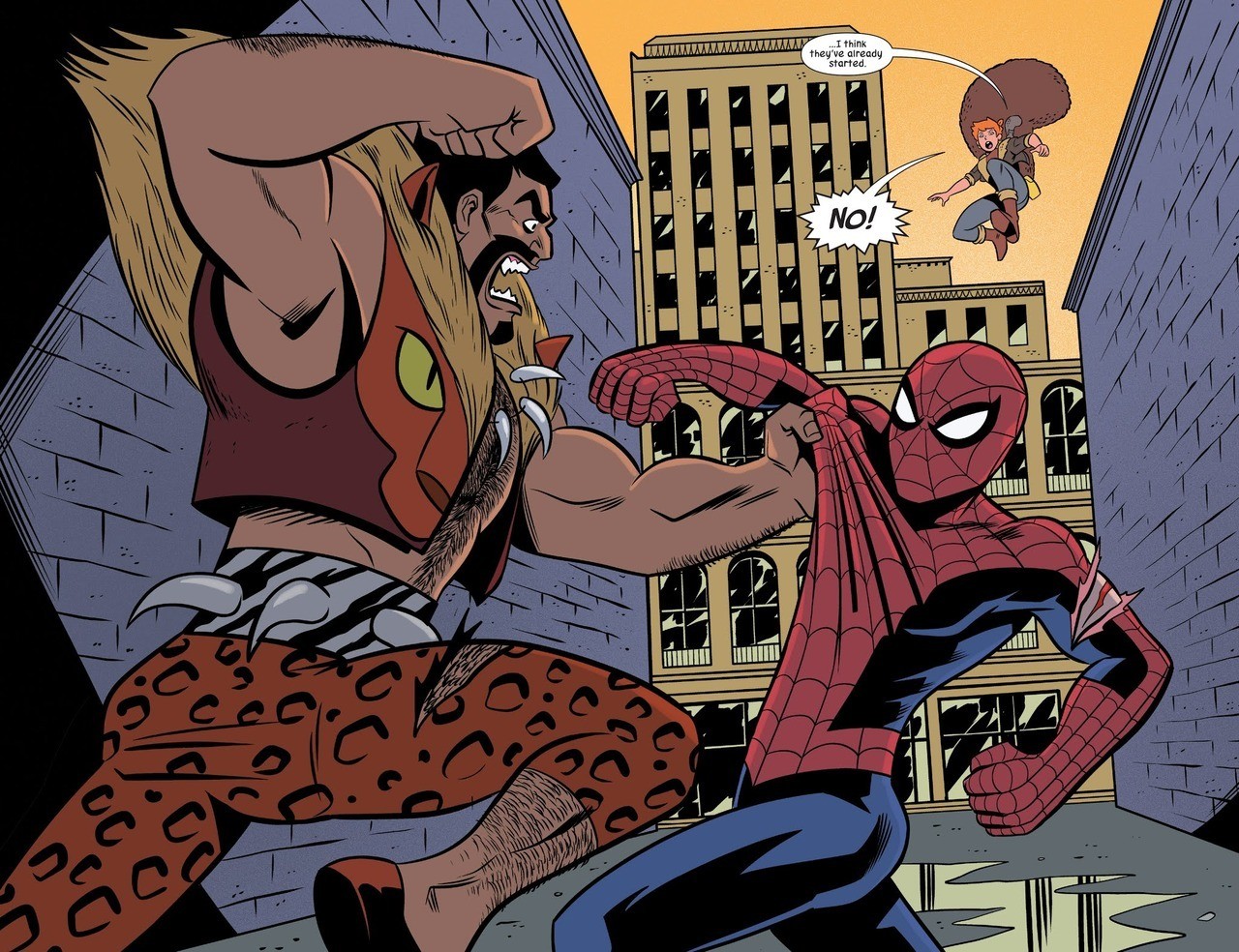
While Charm had followed Henderson already on Jughead, he described this as a different kind of challenge because Squirrel Girl was “completely defined by Erica’s style.” He figured it out, though, with him getting comfortable with the whole cast quickly, save for Doreen herself who took him a few issues to lock in visually.
“It was mainly just trying to find a look that felt like the character Ryan was writing,” Charm said. “I never felt pressure to make it look like Erica’s art, I don’t think anyone wanted a watered-down impression, but I was definitely conscious of keeping the vibe she and Ryan had established over the series up to that point.”
Moss described Charm as the “book’s knight in shining armor,” and someone who made the impossible task of replacing Henderson as smooth as possible.
“A great storyteller, a funny cartoonist, and a quality collaborator — he built a friendship between Brain Drain and Tippy-Toe all on his own in the backgrounds of panels, and then that friendship became a regular part of the book,” Moss said. “Also? Definitive Kraven artist, IMO.”
Renzi made the transition easier, as his colors were a constant throughout the entirety of the series no matter the line artist. While there were slight differences in approach for the colorist – “there are little rendering things I did differently on Derek as I tried to match the colors to his art” – he tried to keep the palette consistent for the two. That made it far smoother than it may have been otherwise.
“Having Rico definitely made it look like Squirrel Girl,” Charm said. “As soon as I saw colors for that first issue, it all just felt right. It was exciting to see the palette he uses on that book applied to my art for the first time.”
“Rico was always in sync with the book. There was no challenge thrown at him that he couldn’t handle with aplomb,” Moss said. “He’d turn in colors for a scene that would really surprise me, like he’d color it in a way I never would have expected it — but then as soon as I see it that way, I can’t imagine it any other way.”
We can’t move on without touting letterer Travis Lanham, the person Moss described as “the book’s secret weapon.” While Cowles created the template for the series, it was “really Travis Lanham’s book,” per Moss.
“In what other superhero comic is there this much lettering? This much involved, ever-changing lettering? And it was clear (Squirrel Girl) was never just a ‘job’ to Travis, he always put in little extra touches — creative lettering ideas that the script hadn’t called for.”
The amazing thing about this series was in an era of rotating creative teams, there was only one main writer, two main artists, one colorist, two letterers and Moss as the primary editor throughout its entirety. For a Marvel title, that’s incredibly rare, and something that moved them beyond just being a team but a family in their own right. It wouldn’t have been the same series if done any other way. North thought it was what made the title as unbeatable as it was, and it was a sentiment everyone I spoke to echoed.
“When you have such a consistent creative team, you become more than just colleagues, you become friends – friends who trust each other. Erica and Derek would change details in the script if they had a better idea. Wil and Sarah (Brunstad, the title’s assistant editor) would make suggestions knowing how I’d take them, knowing we’re all friends and collaborating on making the best book we can. Rico’s colours were not just distinctive and gave the book its own identity in every single issue, but also tied it all together: the switch from Erica to Derek could’ve been rough, but with him colouring both it felt so organic to me, like just another window into this world, and now I can’t imagine our comic without both of them on it. And Clayton and Travis have both been more than patient with my insane lettering requests, bringing their A game every single time,” North told me.
“Maybe this is naïve, but it made Squirrel Girl feel like more of a book in the ‘one bound text’ sense, like these are not individual issues that happen to star the same character but vary wildly in tone and structure and style and intent and message, but rather one single text, a series of adventures that has a start, a middle, and now an end,” he added. “I’m really proud of it, and really thankful that Marvel trusted us all with this for so long.
“As you know, this doesn’t normally happen, and I’m so glad it did here.”
Tomorrow’s 50th issue of The Unbeatable Squirrel Girl is its series finale, as North, Charm, a returning Henderson, Renzi, Lanham and the rest bring this chapter of Doreen Allene Green’s life to a close. It’s something that has been coming for a long time, as North had it in mind “since around the end of the first arc,” with images he envisioned back then making their way into the finale despite so much changing since then.
“Superhero endings are hard because they’re actually impossible: you’re not writing a real ending because nothing really ends, and there will be more Squirrel Girl stories in the future, and I want that too!” North said. “So instead of trying to write ‘this is the last story for Doreen, the end, see you never,’ I instead tried to write ‘this is a story that sums up everything we’ve done and have worked towards since issue one, and at the end of it she’s changed, and the status quo has changed, and now there’s this exciting new normal that sets up new adventures for her down the road.’”
However it ends, it’s impossible to deny the impact on the creators, the characters and even the publisher itself. While it was part of a generation of titles that fit this bill – including Ms. Marvel and Moon Girl and Devil Dinosaur – The Unbeatable Squirrel Girl opened doors for other, more diverse titles for the publisher and even slightly shifted what a Marvel title could or maybe should be going forward. It’s impossible to quantify its larger impact, but it feels like its arrival was a fork in the road moment, and one that led to a possibly better future for the publisher’s comics.
For the creators, the experience meant the world. It changed Henderson’s career forever, for one.
“If people don’t know who you are, they don’t know to hire you. And I’ve made a name for myself and on a book that’s been successful,” Henderson said.
When she started, she was an unknown to many, but now she was the artist on 39 issues and one graphic novel as well as 59 covers for an Eisner-winning series. Squirrel Girl was a path to a better future for her career, and a deserved one at that.
For Charm, it was the longest run of his career, and something that constantly challenged him to find new answers to his art.
“Working that way for 20 months straight has absolutely made me a better artist and storyteller,” he told me.
Much of what the creators involved will miss is tied to the idea of family mentioned before, as it was a special creative team that looked out for one another.
“I never imagined how long the book would run and I’m really going to miss working with everyone,” Renzi said. “It really was a well-oiled machine.
“You can’t take that for granted in comics.”
Some of the team’s favorite parts will carry on forward, of course, like the impact the title had on its audience, something that awed those involved at times.
“It’s crazy to me still, even after having heard it for all these years, how much it meant to a lot of people, and for various reasons,” Henderson told me. “I’ve had a lot of women in computer science who are like, ‘This is great. This is me. I’d never see me anywhere.’ People who have written to us or talked to us about identifying with Koi Boi or dads in their fifties and sixties who are like, ‘Yeah, I read this with my daughter. This is our thing we do together. I send them to her in college and we talk about them.’
“That’s been really cool, just hearing the different stories from people who are using it as a way to build their relationship with someone else, or who see themselves in it when they haven’t seen themselves in other places before.”

All of that is why Squirrel Girl is likely not going to be absent from the world for too long. She’s become an essential part of the Marvel tapestry, with the character even almost making it to television when actress Milana Vayntrub was cast as her in a never-to-be-aired New Warriors series. While The Unbeatable Squirrel Girl is ending tomorrow, a new volume of a successful series is rarely far away when Marvel is involved. North hopes that whenever that happens, Nancy is right there alongside Doreen.
“I hope Nancy becomes even more important to Doreen down the road than she was here: that writing a Squirrel Girl book without Nancy would feel as weird as writing a Superman book without Lois,” he said. “That would make me happy.”
For the scribe, who alongside Renzi and Moss was one of three people to work on each issue of the series, he knows that he’s going to miss “that particular form of storytelling” as much as anything.
“Doreen is so unique in the way she approaches being a superhero that it really changes the way you approach the genre: you can’t copy and paste a Flash story, or a Spider-Man story, or a Paste Pot Pete story, and have it work for Squirrel Girl,” North said. “Which is great, and I think part of what makes her comics so unique – but the downside of that uniqueness for me as a writer is that I won’t be able to do it anymore. Squirrel Girl stories are Squirrel Girl stories and I won’t be able to write that way with anyone else.
“I’m going to miss that, and I’m going to miss her.”
For the fans who have long loved this series, we’re going to be right there with North in missing this character and this title when it concludes. It’s become a true staple at Marvel, and one that may rarely have been touted as the “best” book of the line, but it was almost always my favorite. Whoever follows this team with the character will have big shoes to fill. But if we’ve learned anything from this series – besides the idea that we should “eat nuts and kick butts,” of course – it’s that sometimes the people who we may be wary of at first might be future favorites, and that the next great story could come from anyone with any character. Because of that, I can’t wait to see what’s next for Doreen, Nancy and the rest of the gang, even as the first chapter in their story comes to a close.

